Solving the 2022 NahamCon's CTFs
Recently I stumbled upon the mobile challenges from the NahamCon CTF. Two of them were suitable to solve with Frida, so I decided to give it a try.
Click Me
The Click Me challenge is a small application with a picture of a cookie and a “Get flag” button. If you click on the cookie a counter is increased and if you click the button it tells you that you do not have enough cookies.
To get started, let’s take a look at the code with jadx-gui. Just open up the click_me.apk and look for the MainActivity. Here we find an interesting method called getFlagButtonClick

Here we can see that the cookie has to be clicked almost hundred million times before the flag is presented. In the cookieViewClick method we can also see that the counter will stop increasing at roughly 13 million clicks. So clicking the cookie is obviously not the way to get the flag.
What we do instead is to write a small Frida script that sets the CLICKS member to the desired value when the flag button is clicked.
Java.perform(function(){
var ma = Java.use("com.example.clickme.MainActivity");
ma.getFlagButtonClick.implementation = function(view){
this.CLICKS.value = 99999999;
this.getFlagButtonClick(view);
}
});Now we just launch Frida and load this script while the app is running (frida -U -l clickme.js com.example.clickme) and click the button to get the flag.
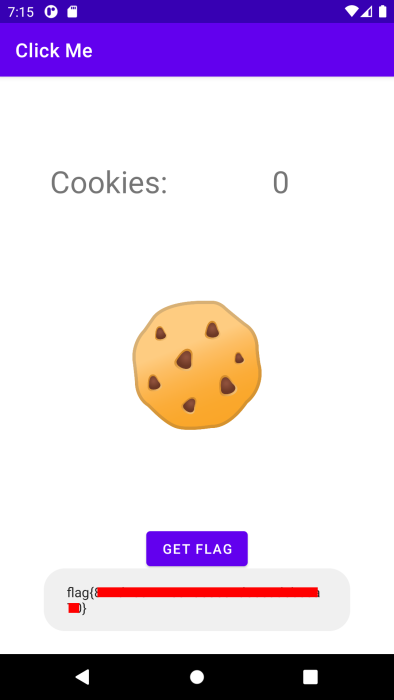
Secure Notes
The Click Me challenge was a good warm up before taking on the Secure Notes challenge, which is a bit more of a challenge. This app asks you to provide a 4 digit pin, and will most likely tell you that it’s the wrong password.
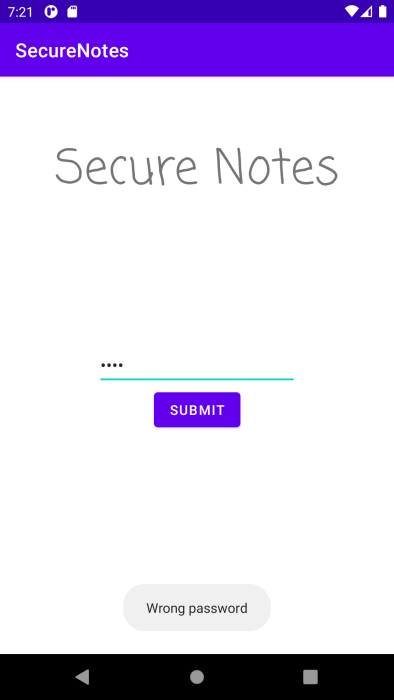
Looking at the code
Let’s take a look at the code using jadx-gui again. Here it’s the LoginActivity that’s most interesting to start with.

Here we can see that the onClick handler for the button calls d.k with the provided pin code repeated four times and two files as arguments. If an exception is thrown the “Wrong password” error message is shown, if no exception is thrown the main activity is launched.
Time to take a look at what the d.k method does.
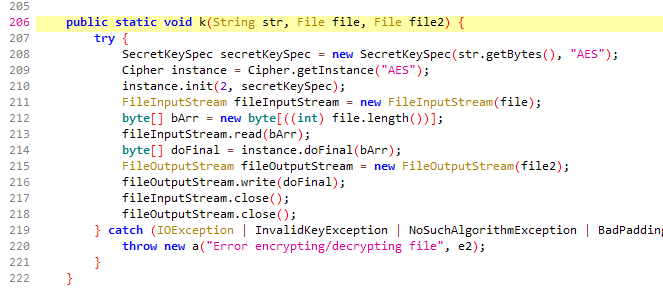
This method uses AES to decrypt one of the files with the stretched pin as key. If the decryption fails, for example due to an invalid key, an exception is thrown. If it succeeds the decrypted data is written to the other file.
When the main activity is later opened it will read the decrypted data and show it on the screen. So to get the flag we need to guess the right pin code. With only 10,000 different possible pins a brute force approach works really well.
Hooking the decryption method
Let’s hook the d.k method since that provides convenient access to the encrypted file. Then instead of calling it with the provided pin, we just call it with all pins sequentially until we find a pin that doesn’t cause an exception to be thrown.
Java.use("o.d").k.implementation = function(pin, input, output) {
console.log("Starting pin brute force attempt");
for(let i = 0; i < 10000; ++i) {
let toTry = String(i).padStart(4, '0');
let nextPin = "" + toTry + toTry + toTry + toTry;
try {
this.k(nextPin, input, output);
console.log("Correct pin found: " + toTry);
return;
} catch (ex) {}
}
}
Running this finds a pin quickly, but something is wrong. The main activity opens up, but it doesn’t show anything. It seems like we found an incorrect pin that can decrypt the data without throwing an exception. But, since the decryption key is wrong, the decrypted data is just garbage.
Finding the correct pin
We need to find a way to check if the data looks reasonable after decryption. To do that, we have to know what kind of data we’re looking for, so let’s open up the main activity and see what it expects.

By looking at the onCreate() method we can see that the data is supposed to be a JSON object. A quick and easy heuristic for detecting JSON is to check if the first byte is { (or 0x7b in hex).
Now that we know what to look for, we need to find a suitable place to do the check. Looking back at d.k we can see that the decrypted data is written to another file with FileOutputStream.write(). This is a convenient method to hook since it’s called with the decrypted data.
let fos = Java.use("java.io.FileOutputStream");
fos.write.overload('[B').implementation = function(bArr) {
if (bArr[0] == 0x7b) {
this.write(bArr);
success = true;
}
}Here we hook the write() method that takes a byte array as input. If the first byte is 0x7b (or {) we call the original write method and set a success variable to true so that we can use this to break the brute force attempt in the d.k hook.
Iteration optimizations
Now we should be able to run through all pins again until we find the right one to get the flag. But I felt like writing a bit more code so I decided to try to minimize the number of iterations needed to find the correct pin.
There are two obvious ways of iterating through 10,000 pins. The first is that you start at 0000 and go up to 9999. The other is starting at 9999 and going down.
I’m guessing that the pin is not a completely random pin, but something chosen by the creator of the CTF. If they would choose a pin close to 0000 or close to 9999 it could be found even with a very inefficient brute force method, or even by manual testing using one of the obvious methods. I’m assuming that the CTF maker has taken this into consideration and chosen a pin that’s somewhere close to the middle so that you have to try several thousand pins regardless of what direction you iterate in.
Due to this I’m taking a different approach and start with the pin 5000 and iterate outwards in both directions. That way I’ll find pins close to the middle faster than pins toward the end.
To be able to do this let’s write a small function that calculates the next offset from the start pin given the current one:
function nextOffset(offset) {
if (offset >= 0) {
offset++;
}
return offset * -1;
}This function basically flips the sign every time it’s called and increases the value by one every second time. So when called a couple of times, with the previous offset as a parameter it will return: -1, 1, -2, 2, -3, 3, ....
Now we can use this function to iterate outwards from 5000 until we find the pin:
let success = false;
Java.use("o.d").k.implementation = function(pin, input, output) {
let start = 5000;
let offset = 0;
success = false;
console.log("Starting pin brute force attempt");
while (Math.abs(offset) <= 5000) {
toTry = String(start + offset).padStart(4, '0');
let nextPin = "" + toTry + toTry + toTry + toTry;
try {
this.k(nextPin, input, output);
if (success) return;
} catch (ex) {}
offset = nextOffset(offset);
}
}Getting the flag
With this, all the code is in place and we can just load the script and tap the submit button to find the correct one. With some additional printouts added we also get some progress details from the Frida script.
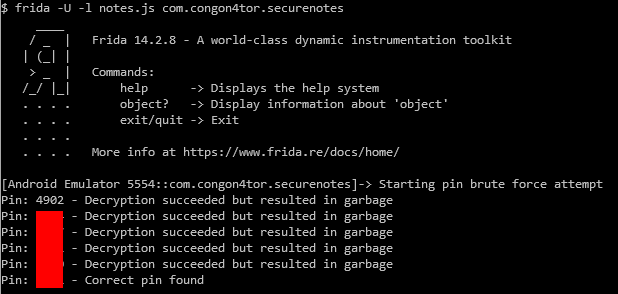
Since we abort the brute force attempt when we find the correct pin there will be no exception thrown and the main activity will be opened automatically showing us the flag.
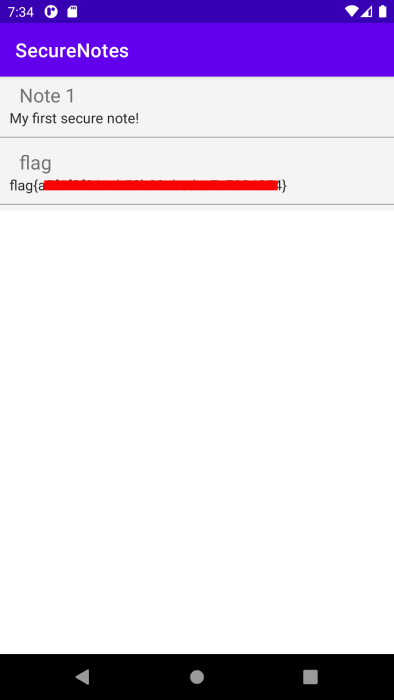
The complete code for both these challenges is available on GitHub.